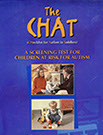Autism Screening Using the CHAT
While at the Douglas Hospital, I received funding from the Montreal Regional Health Board to initiate the first systematic implementation of the Checklist for Autism in Toddlers in North America, in collaboration with Dr. Simon Baron Cohen and his team at Cambridge University (De Kimpe, Tremplay, & Doehring, 2000). I conducted follow-up telephone interviews to confirm risk status, and conducted full diagnostic assessments for 18-24 month-old children considered at moderate to high risk for autism or a related developmental disorder.
Despite the promise of the CHAT, regional adoption of a screening and diagnostic protocol I proposed (centered on the CHAT, ADOS, and ADI-R) stalled because of the challenges aligning the efforts of diagnostic teams in different hospitals, and the gaps and delays in follow-up, specialized care. In the course of this work, I developed a training video and manual for the CHAT (Doehring, deKimpe, Tremblay, Baron-Cohen, Wheelwright, Cox, Baird, Swettenham, Drew, & Charman, 2001), parts of which were incorporated into materials used by Dr. Baron Cohen's team (Baron-Cohen, Wheelwright, Cox, Baird, Charman, Swettenham, Drew, & Doehring, 2000). This also led to a summer as a visiting researcher with Drs. Gillian Baird and Tony Charman, in their attempts to develop new instruments for assessing young children with autism.
Related Content
On this site
 Translating research into effective community practice requires systematic planning and collaboration across researchers, practitioners, and agencies
Translating research into effective community practice requires systematic planning and collaboration across researchers, practitioners, and agencies
During this period, my research and publications centered on the deficits in pretend play and joint attention that appeared to be distinct to ASD, and their possible role in identifying ASD and in understanding its developmental trajectory. I was especially excited by the fact that the critical markers on the Checklist for Autism in Toddlers or CHAT drew on these same deficits. The body of research leading to the CHAT appeared to demonstrate the potential of basic science to reveal distinct characteristics of ASD, with very profound and direct implications for assessment and treatment.
Yet my subsequent attempts to integrate the CHAT into a regional network of early identification and intervention fell short, because of gaps in the overall coordination of services, training, and policy across school-, hospital-, university-, and community-based programs. This was a seminal experience, ultimately leading me to focus on how to implement existing research rather than generate new data. As I describe in detail in my 2013 Roadmaps book, the persistent failure across the USA to utilize the CHAT (and its successor the M-CHAT) exemplifies how researchers, policymakers, advocates, and practitioners continue to under-estimate the challenge of translating research into practice and outcomes.





